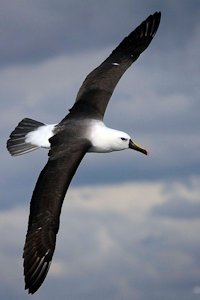
|
Soaring Seabirds in Bird Flight - Page 2
Since soaring flight over the oceans places quite different demands on the physiology on the bird tan does soaring in thermals, the wings of soaring seabirds have evolved quite differently from those of soaring land birds. In the continuously fluctuating wind conditions over the sea, with gusts changing in direction from one second to the next, a land bird's wings would be sadly out of place. To utilize the lift from rising air masses, the wings of a soaring land bird need to be broad and to present a large surface area; excessive length would cause difficulties in maneuverability. The large maritime soaring birds have the largest wing spans. The Wandering Albatross takes first place in a wing span of over 11.5 feet from wing tip to wing tip and weighs 17.5 pounds. Albatrosses are the masters of gust flying. Their wings are quite narrow, the forearm portion is unusually long, and the hand portion, in contrast, is relatively short. The entire wing is built for rigidity in the turbulence of sea breezes, and the primary and secondary quills are relatively short and stiff so that the tips will not flutter. Flutter at the wing tips or at the trailing edges (as opposed to the leading edges) of airfoils vortex formation (violent, whirling air masses) and leads to an uncontrollable loss of energy. The long forearm on the albatross wing bears as many as 37 secondary feathers, but the number of primaries, at 10, is no greater than in other birds. This numerical proportion alone indicates the great extension in the length of the forearm, which constitutes the greater part of the airfoil. |
| Laysan Albatross |